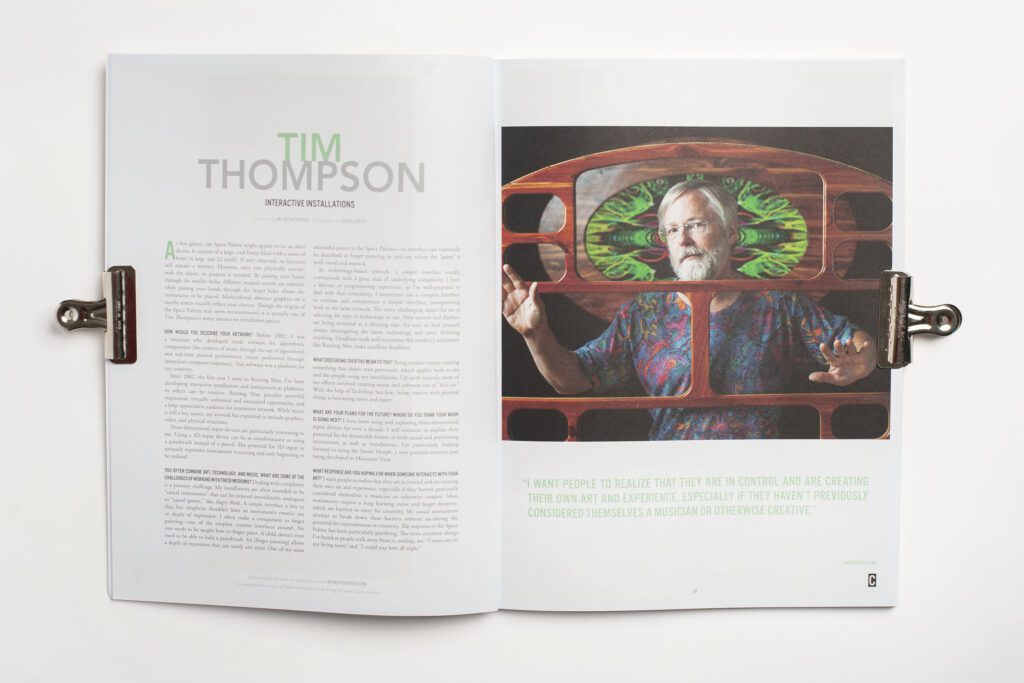
At first glance, the Space Palette might appear to be an alien device. It consists of a large, oval frame filled with a series of holes (4 large and 12 small). If only observed, its function will remain a mystery. However, once you physically interact with the object, its purpose is revealed. By passing your hands through the smaller holes, different musical sounds are selected, while passing your hands through the larger holes allows the instrument to be played. Multicolored, abstract graphics on a nearby screen visually reflect your choices. Though the origins of the Space Palette may seem extraterrestrial, it is actually one of Tim Thompson’s many interactive installation pieces.
How would you describe your artwork?
Before 2002, I was a musician who developed nerdy software for algorithmic composition [the creation of music through the use of algorithms] and real-time musical performance [music performed through immediate computer responses]. This software was a platform for my creativity.
Since 2002, the first year I went to Burning Man, I’ve been developing interactive installations and instruments as platforms so others can be creative. Burning Man provides powerful inspiration, virtually unlimited and uncurated opportunities, and a large appreciative audience for interactive artwork. While music is still a key aspect, my artwork has expanded to include graphics, video, and physical structures.
Three-dimensional input devices are particularly interesting to me. Using a 3D input device can be as transformative as using a paintbrush instead of a pencil. The potential for 3D input in uniquely expressive instruments is exciting and only beginning to be realized.
You often combine art, technology, and music. What are some of the challenges of working with these mediums?
Dealing with complexity is a primary challenge. My installations are often intended to be “casual instruments” that can be enjoyed immediately, analogous to “casual games,” like Angry Birds. A simple interface is key to this, but simplicity shouldn’t limit an instrument’s creative use or depth of expression. I often make a comparison to finger painting—one of the simplest creative interfaces around. No one needs to be taught how to finger paint. A child doesn’t even need to be able to hold a paintbrush. Yet [finger painting] allows a depth of expression that can satisfy any artist. One of my most successful pieces is the Space Palette—its interface can essentially be described as finger painting in mid-air, where the “paint” is both visual and musical.
“Using a 3D input device can be as transformative as using a paintbrush instead of a pencil.”
Tim Thompson
In technology-based artwork, a simple interface usually corresponds with a great deal of underlying complexity. I have a lifetime of programming experience, so I’m well-prepared to deal with that complexity. I sometimes use a complex interface to contrast and complement a simple interface, incorporating both in the same artwork. The more challenging aspect for me is selecting the type of technology to use. New sensors and displays are being invented at a dizzying rate. It’s easy to find yourself always investigating the latest technology and never finishing anything. Deadlines work well to combat this tendency, and events like Burning Man make excellent deadlines.
What does being creative mean to you?
Being creative means creating something that didn’t exist previously, which applies both to me and the people using my installations. Up until recently, most of my efforts involved creating music and software out of “thin air.” With the help of TechShop San Jose, being creative with physical things is becoming easier and easier.
What are your plans for the future? Where do you think your work is going next?
I have been using and exploring three-dimensional input devices for over a decade. I will continue to explore their potential for the foreseeable future, in both casual and performing instruments as well as installations. I’m particularly looking forward to using the Sensel Morph, a new pressure-sensitive pad being developed in Mountain View.
What response are you hoping for when someone interacts with your art?
I want people to realize that they are in control and are creating their own art and experience, especially if they haven’t previously considered themselves a musician or otherwise creative. Most instruments require a long learning curve and finger dexterity, which are barriers to entry for creativity. My casual instruments attempt to break down these barriers without sacrificing the potential for expressiveness or creativity. The response to the Space Palette has been particularly gratifying. The most common things I’ve heard as people walk away from it, smiling, are: “I want one in my living room” and “I could stay here all night.”

